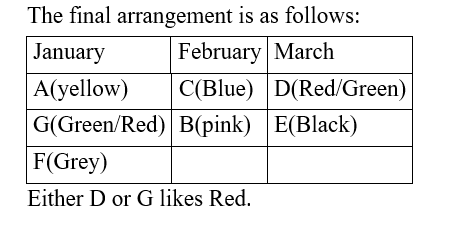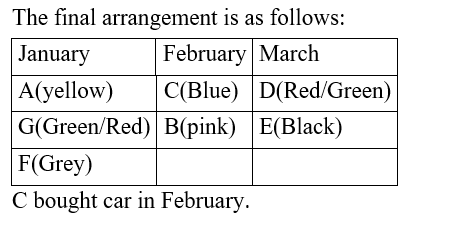Question 1:
निर्देश : दिए गए जानकारी के आधार पर सवालों के उत्तर दें।
Directions : Answer the questions based on the information given below.
सात व्यक्ति, A, B, C, D, E, F और G को भिन्न भिन्न रंग पसंद है - हरा, नीला, काला, पीला, गुलाबी, ग्रे और लाल।इनमे से प्रत्येक समान वर्ष के तीन विभिन्न महीने में कार खरीदते हैं (जनवरी, फरवरी और मार्च)।
Seven persons, A, B, C, D, E, F and G like different colours, Green, Blue, Black, Yellow, Pink, Grey, and Red. Each of them bought car in three different months (January, February and March) in the same year.
कम से कम दो व्यक्ति समान महीने में कार खरीदते हैं।वह व्यक्ति, जिसे नीला पसंद है, 31 दिनों के महीने में कार नहीं खरीदता है। A को पीला पसंद है और वह जनवरी में कार खरीदता है। D मार्च में कार खरीदता है। दोनों G और F समान महीने में कार खरीदते हैं। B, जिसे गुलाबी पसंद है, फरवरी में कार खरीदता है।ना ही G ना ही F को नीला पसंद है। E को काला पसंद है।ना ही D ना ही G को ग्रे पसंद है। वह व्यक्ति, जिसे हरा और लालपसंद है, समान महीने में कार नहीं खरीदता है।
At least two persons bought car in the same month. Person, who likes Blue doesn’t buy car in the month of 31 days. A likes Yellow and bought car in January. D bought car in March. Both G and F bought car in the same month. B, who likes Pink, bought car in February. Neither G nor F likes Blue. E likes Black. Neither D nor G likes Grey. Persons, who like Green and Red don’t buy the car in the same month.
______ को लाल पसंद है।
____ likes Red.
Question 2:
निर्देश : दिए गए जानकारी के आधार पर सवालों के उत्तर दें।
Directions : Answer the questions based on the information given below.
सात व्यक्ति, A, B, C, D, E, F और G को भिन्न भिन्न रंग पसंद है - हरा, नीला, काला, पीला, गुलाबी, ग्रे और लाल।इनमे से प्रत्येक समान वर्ष के तीन विभिन्न महीने में कार खरीदते हैं (जनवरी, फरवरी और मार्च)।
Seven persons, A, B, C, D, E, F and G like different colours, Green, Blue, Black, Yellow, Pink, Grey, and Red. Each of them bought car in three different months (January, February and March) in the same year.
कम से कम दो व्यक्ति समान महीने में कार खरीदते हैं।वह व्यक्ति, जिसे नीला पसंद है, 31 दिनों के महीने में कार नहीं खरीदता है। A को पीला पसंद है और वह जनवरी में कार खरीदता है। D मार्च में कार खरीदता है। दोनों G और F समान महीने में कार खरीदते हैं। B, जिसे गुलाबी पसंद है, फरवरी में कार खरीदता है।ना ही G ना ही F को नीला पसंद है। E को काला पसंद है।ना ही D ना ही G को ग्रे पसंद है। वह व्यक्ति, जिसे हरा और लालपसंद है, समान महीने में कार नहीं खरीदता है।
At least two persons bought car in the same month. Person, who likes Blue doesn’t buy car in the month of 31 days. A likes Yellow and bought car in January. D bought car in March. Both G and F bought car in the same month. B, who likes Pink, bought car in February. Neither G nor F likes Blue. E likes Black. Neither D nor G likes Grey. Persons, who like Green and Red don’t buy the car in the same month.
निम्नलिखित में से कौन जनवरी में कार खरीदता है?
Who among the following bought the car in January?
Question 3:
निर्देश : दिए गए जानकारी के आधार पर सवालों के उत्तर दें।
Directions : Answer the questions based on the information given below.
सात व्यक्ति, A, B, C, D, E, F और G को भिन्न भिन्न रंग पसंद है - हरा, नीला, काला, पीला, गुलाबी, ग्रे और लाल।इनमे से प्रत्येक समान वर्ष के तीन विभिन्न महीने में कार खरीदते हैं (जनवरी, फरवरी और मार्च)।
Seven persons, A, B, C, D, E, F and G like different colours, Green, Blue, Black, Yellow, Pink, Grey, and Red. Each of them bought car in three different months (January, February and March) in the same year.
कम से कम दो व्यक्ति समान महीने में कार खरीदते हैं।वह व्यक्ति, जिसे नीला पसंद है, 31 दिनों के महीने में कार नहीं खरीदता है। A को पीला पसंद है और वह जनवरी में कार खरीदता है। D मार्च में कार खरीदता है। दोनों G और F समान महीने में कार खरीदते हैं। B, जिसे गुलाबी पसंद है, फरवरी में कार खरीदता है।ना ही G ना ही F को नीला पसंद है। E को काला पसंद है।ना ही D ना ही G को ग्रे पसंद है। वह व्यक्ति, जिसे हरा और लालपसंद है, समान महीने में कार नहीं खरीदता है।
At least two persons bought car in the same month. Person, who likes Blue doesn’t buy car in the month of 31 days. A likes Yellow and bought car in January. D bought car in March. Both G and F bought car in the same month. B, who likes Pink, bought car in February. Neither G nor F likes Blue. E likes Black. Neither D nor G likes Grey. Persons, who like Green and Red don’t buy the car in the same month.
_____ को _____ रंग पसंद है।
____ likes _____ colour.
Question 4:
निर्देश : दिए गए जानकारी के आधार पर सवालों के उत्तर दें।
Directions : Answer the questions based on the information given below.
सात व्यक्ति, A, B, C, D, E, F और G को भिन्न भिन्न रंग पसंद है - हरा, नीला, काला, पीला, गुलाबी, ग्रे और लाल।इनमे से प्रत्येक समान वर्ष के तीन विभिन्न महीने में कार खरीदते हैं (जनवरी, फरवरी और मार्च)।
Seven persons, A, B, C, D, E, F and G like different colours, Green, Blue, Black, Yellow, Pink, Grey, and Red. Each of them bought car in three different months (January, February and March) in the same year.
कम से कम दो व्यक्ति समान महीने में कार खरीदते हैं।वह व्यक्ति, जिसे नीला पसंद है, 31 दिनों के महीने में कार नहीं खरीदता है। A को पीला पसंद है और वह जनवरी में कार खरीदता है। D मार्च में कार खरीदता है। दोनों G और F समान महीने में कार खरीदते हैं। B, जिसे गुलाबी पसंद है, फरवरी में कार खरीदता है।ना ही G ना ही F को नीला पसंद है। E को काला पसंद है।ना ही D ना ही G को ग्रे पसंद है। वह व्यक्ति, जिसे हरा और लालपसंद है, समान महीने में कार नहीं खरीदता है।
At least two persons bought car in the same month. Person, who likes Blue doesn’t buy car in the month of 31 days. A likes Yellow and bought car in January. D bought car in March. Both G and F bought car in the same month. B, who likes Pink, bought car in February. Neither G nor F likes Blue. E likes Black. Neither D nor G likes Grey. Persons, who like Green and Red don’t buy the car in the same month.
निम्नलिखित में से कौन सा कथन सत्य है?
Which among the following statement is/are true?
Question 5:
निर्देश : दिए गए जानकारी के आधार पर सवालों के उत्तर दें।
Directions : Answer the questions based on the information given below.
सात व्यक्ति, A, B, C, D, E, F और G को भिन्न भिन्न रंग पसंद है - हरा, नीला, काला, पीला, गुलाबी, ग्रे और लाल।इनमे से प्रत्येक समान वर्ष के तीन विभिन्न महीने में कार खरीदते हैं (जनवरी, फरवरी और मार्च)।
Seven persons, A, B, C, D, E, F and G like different colours, Green, Blue, Black, Yellow, Pink, Grey, and Red. Each of them bought car in three different months (January, February and March) in the same year.
कम से कम दो व्यक्ति समान महीने में कार खरीदते हैं।वह व्यक्ति, जिसे नीला पसंद है, 31 दिनों के महीने में कार नहीं खरीदता है। A को पीला पसंद है और वह जनवरी में कार खरीदता है। D मार्च में कार खरीदता है। दोनों G और F समान महीने में कार खरीदते हैं। B, जिसे गुलाबी पसंद है, फरवरी में कार खरीदता है।ना ही G ना ही F को नीला पसंद है। E को काला पसंद है।ना ही D ना ही G को ग्रे पसंद है। वह व्यक्ति, जिसे हरा और लालपसंद है, समान महीने में कार नहीं खरीदता है।
At least two persons bought car in the same month. Person, who likes Blue doesn’t buy car in the month of 31 days. A likes Yellow and bought car in January. D bought car in March. Both G and F bought car in the same month. B, who likes Pink, bought car in February. Neither G nor F likes Blue. E likes Black. Neither D nor G likes Grey. Persons, who like Green and Red don’t buy the car in the same month.
निम्नलिखित में से किस महीने में तीन व्यक्ति कार खरीदते हैं?
In which of the following months three persons bought the car?
Question 6:
निम्नलिखित में से कौन सा अक्षर बाएं छोर से छठा अक्षर होगा यदि शब्द “NURSERY” में सम स्थानों पर स्थित अक्षरों को अगले अक्षर से इस प्रकार प्रतिस्थापित किया जाए कि बाएं छोर से “N” विषम स्थान पर हो और “U” सम स्थान पर हो और इसी प्रकार आगे भी?
Which of the following letter will be 6th letter from the left end if the letters at even positions are replaced by succeeding letter in the word “NURSERY” such that from left end “N” is at odd position and “U” is at even position and so on?
Question 7:
शब्द “HANGOUTS” में अक्षरों के ऐसे कितने जोड़े हैं जिनके बीच शब्द में उतने ही अक्षर हैं जितने वर्णमाला श्रृंखला में हैं?
How many pairs of letters are there in the word “HANGOUTS” which has as many letters between them in the word as in the alphabetical series?
Question 8:
निर्देश : निम्नलिखित व्यवस्था का ध्यानपूर्वक अध्ययन करें और प्रश्नों के उत्तर दें।
Directions : Study the following arrangement carefully and answer the questions.
6 H 9 K 3 D V B 2 M 1 Y I 7 O 4 W 5 8 S L P Z R
कितने अक्षरों के ठीक पहले एक अभाज्य संख्या है?
How many alphabets are immediately preceded by a prime number?
Question 9:
निर्देश : निम्नलिखित व्यवस्था का ध्यानपूर्वक अध्ययन करें और प्रश्नों के उत्तर दें।
Directions : Study the following arrangement carefully and answer the questions.
6 H 9 K 3 D V B 2 M 1 Y I 7 O 4 W 5 8 S L P Z R
बाएं छोर से दूसरी संख्या और दाएं छोर से तीसरी संख्या का योग क्या है?
What is the sum of 2nd number from left end and 3rd number from right end?
Question 10:
निर्देश : निम्नलिखित व्यवस्था का ध्यानपूर्वक अध्ययन करें और प्रश्नों के उत्तर दें।
Directions : Study the following arrangement carefully and answer the questions.
6 H 9 K 3 D V B 2 M 1 Y I 7 O 4 W 5 8 S L P Z R
बाएं छोर से पहली अभाज्य संख्या के दाईं ओर कितने स्वर हैं?
How many vowels are to the right of 1st prime number from the left end?





